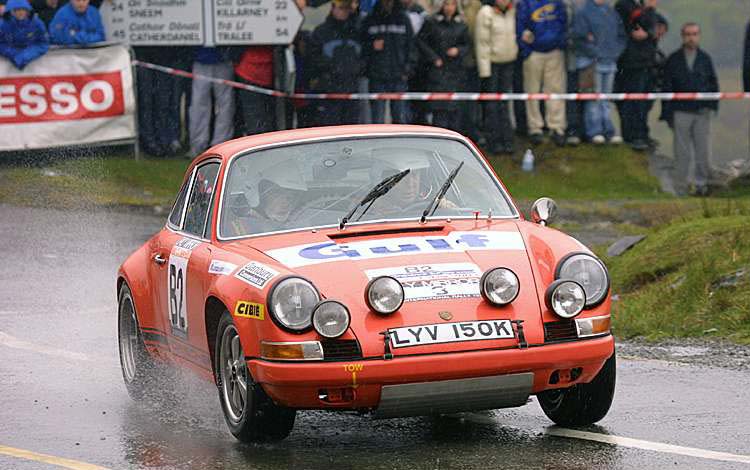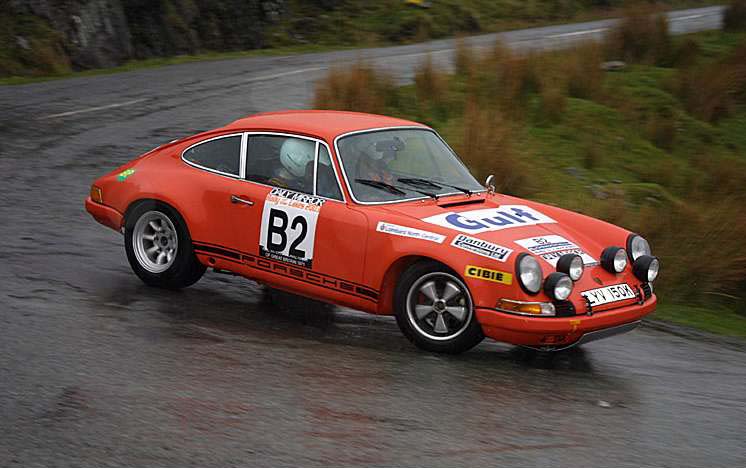Não sei (eu, pelo menos, não encontrei) se há por aqui algum tópico com este titulo ou algo parecido; mas , depois de querer saber tudo àcerca da "bomba verde", dei com um artigo que me escuso a traduzir e que faço copy/past na integra.
Espero que agrade a alguém do mesmo modo que me agradou a mim ler mais uma "história sobre rodas".
Apreciem:
Porsche 911S/T background information
The majority of the following text is courtesy of John Starkey, johnstarkeycars.com, author of the book Porsche 911 — R-RS-RSR. Some additional details have been added by Bill Noon, specific to this vehicle.
In 1970 new rules allowed the wheelarches of the 911 to be extended (flared) a further 2 inches from standard to accommodate wider wheels and beginning with the “C” series, the engine capacity was increased to 2195cc by increasing the bore to 84 mm. Porsche could now enlarge the cubic capacity of the engine by bore increase only, as per the regulations, to enable them to run at the next class limit of 2.5-litres and they accomplished this objective in several stages.
At the first stage the capacity of the engine was increased to 2247cc, an increase in bore of just 1 mm to 85 mm. At the same time, the factory made use of “Biral” cylinders which consisted of cast iron cylinders with alloy fins bonded on. Twin ignition had now been homologated (with normal coils and contact breakers) and this was part of the engine tune, together with polished and crack-tested connecting rods.
Compression ratio on the 2247cc “S” model was 10.3:1. As before, standard valves were used (46 mm inlet and 40 mm exhaust). Bosch twin-row, six-plunger pump (mechanical) fuel injection was now being used in the production cars, the pump of which was modified with a space cam to match the Carrera 6 racing cams which were installed. Tuned induction pipes without an air filter were used. The racing engine for Group 4 could be had with Weber 46 IDA carburetors with 42 mm diameter choke tubes. Strangely, the factory-claimed power output of 230 bhp was the same for both versions.
The standard crankshaft and bearings were used. Thirty of these engines were built, the factory designating them “Type 911/20.”
For the twenty cars that were built to take these engines, the roofs, parts of the floorpans and the scuttles were manufactured in thinner gauge steel than that used for the road cars. Cars retained and run by the factory employed thinner steel for their doors, too. In March 1971, the cylinder bores were opened further to 87.5 mm and this increased the capacity to 2381cc. Output of this engine was 250 bhp, both fuel injection and carburetor versions achieving this peak power at 7800 rpm. Torque values were 170.3 lbs/ft. for the 2.3-litre engine and 188.4 lb/ft. for the 2.4-litre engine, both at 6200 rpm.
These racing versions of the 911, which were known internally by Porsche as “S/Ts,” had their seat slide supports and the heater ducts removed, as were the seatbelt anchorage points, the glovebox lid and the ashtray. Missing also were the engine cover and front cover locks (these being replaced by rubber fasteners), the sun visor, the front torsion bar protectors, the foglight recess covers and the rear torsion bar covers. There was no soundproofing or underseal and even the amount of paint used was kept to a minimum. Further options from the factory in order to lose still more weight included a plastic front cover as well as front and rear bumpers made of the same material, and aluminum skinned doors with steel frames of 0.75 mm thickness. Plexiglass was available to replace all glass except for the wind-screen which, however, could be had with even thinner glass.
A transverse bar was fitted in the front compartment between the front struts to aid stiffness in this area and fuel tanks of 17.6 or 24.2 gallons were available. For racing, 7 inch front and 9 inch rear wheel widths were used. Racing tire sizes were 4.75/10.00-15 and 4.75/11.30-15 respectively. The whole body package was finished off with Recaro sports seats.
For rallying, Porsche modified the “S/T’ 2.3-litre engine only slightly by removing the air filter, skimming 0.5 mm off the heads, fitting a rally exhaust system and richening up the fuel/air mixture. A lightened flywheel and stronger clutch were used. Porsche quoted 190 bhp from this engine set-up. Apart from the gearbox casing being made of magnesium, the box itself was of a new, strengthened, design designated “Type 911.” Many combinations of gearbox ratios were offered and the final drive ratio could be 7.31 or 6.32. Each rear halfshaft employed two constant velocity joints. 6 inch wheel rim widths were used for rallying with 185/70 VRl5 tires. For braking, ventilated discs with aluminum “S” calipers were used at the front whilst “M” steel calipers were used at the rear: recommended linings were of Textar 1431 G for racing. Suspension was judged good enough by the factory to employ the same type of settings as for the 2-litre car, that is the car was lowered by adjusting the torsion bars and anti-roll bars of differing diameters were made available for racing. To take complete advantage of the 2.5-litre class limit, Porsche supplied several sets of components for customers who wanted engines of this size. In fact, Porsche built two prototype 2.5-litre engines of differing stroke/bore combinations due to a problem they encountered with the first design.
The first design took advantage of the “E” production variant, having piston stroke increased to 70.4 mm (previously 66 mm) in conjunction with a bore increased to 86.7 mm: the result was a cubic capacity (2494 cc) at the class limit. Otherwise the 2.5’s specification was as the 2.4-litre unit. In its new size, the engine now developed 275bhp at 7900 rpm and 196 lbs/ft. of torque at 6200 rpm.
The problem with the first 2.5-litre engine was that it tended to loosen its flywheel bolts or, in extreme cases, break its crankshaft. There was little doubt at the factory that this was due to the longer stroke now being used and so some engines were built using the previous stroke of 66 mm whilst employing “Nikasil” cylinders with a bore of 89 mm. This resulted in the same power and torque figures as the long-stroke engine without its fragility.
A new gearbox (Type 915) was offered with the 2.5-litre racer, having a torque rating of 217 lb/ft, more than 20 per cent higher than the “Type 91l” gearbox which had reached its limit with the 2.4-litre car. An oil pump was now incorporated into the front cover of the gearbox and this sprayed jets of oil onto the gear clusters instead of the splash lubrication previously employed, which had absorbed 7 bhp at maximum speed. The distance between shaft centers was now 77 mm whilst the first gear pinion was cut on the mainshaft. This meant that the mainshaft had to be changed to change the first gear ratio. The crownwheel and pinion ratios offered were now 7.31 or 7.37.
For the “915” gearbox, the opportunity was taken to change the gear-shift pattern so that 1st gear (previously left and back) was now forward, in front of 2nd gear. Fifth gear was now to the right and forward with reverse situated directly behind 5th. This change was in response to road car drivers who complained about the racing type lst-2nd gearchange associated with the previous 5-speed gear-boxes. They much preferred 1st and 2nd gear selection in one plane
On the “E” series, also, a small front air dam was mounted beneath the front bumper and the engine oil cooler was now mounted in the center of this with its piping taken beneath the sill on the right-hand side.
The only change in the suspension was a move from Koni to Bilstein dampers and these were employed with harder settings than on the road cars. From the factory, these G.T. racing cars cost DM 49,680.
In its final form the last of the 911 S/Ts were the lightest and most powerful Porsche GT competition coupes built. Even with the advent of the 911 RSR, the 2.5-liter S/Ts were significantly lighter while only giving up 45bhp to the 3.0-liter RSRs. Several late production and factory upgraded 2.5-liter 911 S/Ts weighed in at a mere 920 to 930 kgs and produced 280bhp at an astounding 8000rpm!
Later production 911 racers would produce ever more horsepower. They would however all gain significant weight and lose the original pure lines of the early 911s. With the end of the limited production 911 S/Ts, never again would Porsche produce such a lightweight and powerful racer. In the end no more than 22 S/Ts were completed by Porsche making it one of the rarest and most sought after examples ever produced
Ficam também algumas imagens esclarecedoras da PUREZA das linhas, já que o texto atesta o suficiente sobre a proeza mecânica realizada num 2500 a debitar brutalidades de cavalos. Certo! Algo "pontudo" mas em todo o caso: F A B U L O S O !




E aqui: O "nosso"!!!



